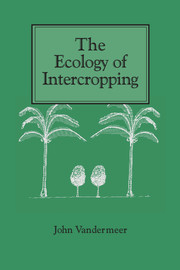Book contents
- Frontmatter
- Contents
- Preface
- 1 Introduction: intercrops and ecology
- 2 The measurement of intercrop performance
- 3 The competitive production principle
- 4 Facilitation
- 5 Mechanisms of the competitive production principle
- 6 The environments modified to produce facilitation
- 7 Special problems in intercrops involving perennials
- 8 Weeds and intercrops
- 9 Variability and intercrops
- 10 Planning intercrops – a phenomenological approach
- 11 Planning intercrops – a mechanistic approach
- 12 Critical research directions for the future
- References
- Author index
- Subject index
11 - Planning intercrops – a mechanistic approach
Published online by Cambridge University Press: 05 August 2012
- Frontmatter
- Contents
- Preface
- 1 Introduction: intercrops and ecology
- 2 The measurement of intercrop performance
- 3 The competitive production principle
- 4 Facilitation
- 5 Mechanisms of the competitive production principle
- 6 The environments modified to produce facilitation
- 7 Special problems in intercrops involving perennials
- 8 Weeds and intercrops
- 9 Variability and intercrops
- 10 Planning intercrops – a phenomenological approach
- 11 Planning intercrops – a mechanistic approach
- 12 Critical research directions for the future
- References
- Author index
- Subject index
Summary
Introduction
While the phenomenological approach of the previous chapter was conducive to generalization, it is, almost by definition, impossible to generalize about the subject of this chapter. Since the mechanistic view includes such a wide variety of topics, from insect movements to shading to resource utilization, no single methodology is possible. Nevertheless, it is possible to group mechanisms into broad categories and discuss potential approaches within each of these categories.
Following the overall structure of this book, the mechanistic approach is presented in two broad categories, mechanisms of reduced competition and mechanisms of facilitation. Within the category of reduced competition are included two topics: partitioning the light environment, and partitioning resources. For the same reason that it was possible to develop an analytical approach to the environmental impact of one species on the environment of the other, in chapter 7 a potential engineering approach is possible when competition between two annuals is known to be for light. Since light is unidirectional, there are certain inevitable rules upon which one can build, at least provisionally. On the contrary, when competition is for resources no such inevitable rules are obvious.
Within the category of facilitation, above and beyond the clear planning implications of Chapters 4 and 6, which are not repeated here, there are three topics elaborated, all associated with pest control. First, the so-called ‘trivial’ movements of pests and predators, which is to say their movement patterns within a field after having arrived, are treated with the standard application of diffusion equations.
- Type
- Chapter
- Information
- The Ecology of Intercropping , pp. 176 - 188Publisher: Cambridge University PressPrint publication year: 1989



